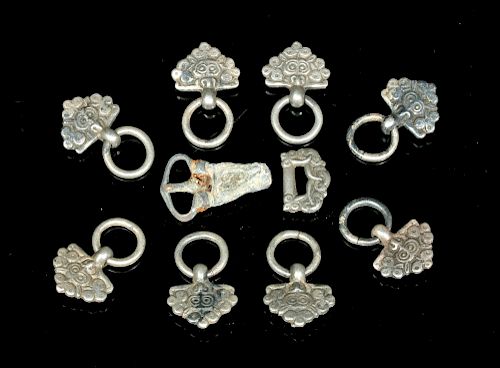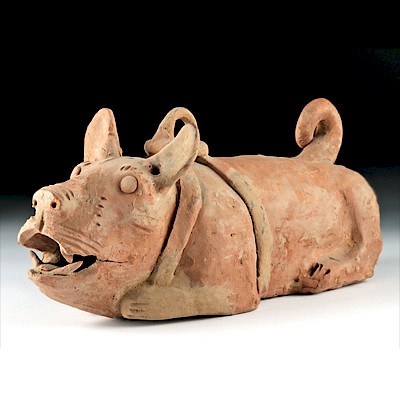Rare Viking Gilt Silver Belt Mount Group (Ten)
Lot 33
About Seller
Artemis Gallery
686 S Taylor Ave, Ste 106
Louisville, CO 80027
United States
Selling antiquities, ancient and ethnographic art online since 1993, Artemis Gallery specializes in Classical Antiquities (Egyptian, Greek, Roman, Near Eastern), Asian, Pre-Columbian, African / Tribal / Oceanographic art. Our extensive inventory includes pottery, stone, metal, wood, glass and textil...Read more
Estimate:
$1,500 - $3,000
Absentee vs Live bid
Two ways to bid:
- Leave a max absentee bid and the platform will bid on your behalf up to your maximum bid during the live auction.
- Bid live during the auction and your bids will be submitted real-time to the auctioneer.
Bid Increments
| Price | Bid Increment |
|---|---|
| $0 | $25 |
| $300 | $50 |
| $1,000 | $100 |
| $2,000 | $250 |
| $5,000 | $500 |
| $10,000 | $1,000 |
| $20,000 | $2,500 |
| $50,000 | $5,000 |
| $100,000 | $10,000 |
| $200,000 | $20,000 |
About Auction
By Artemis Gallery
Sep 13, 2018
Set Reminder
2018-09-13 10:00:00
2018-09-13 10:00:00
America/New_York
Bidsquare
Bidsquare : Ancient | Asian | Ethnographic - Fall Variety
https://www.bidsquare.com/auctions/artemis-gallery/ancient-asian-ethnographic---fall-variety-3432
Travel the world and back in time... Antiquities from Egypt, Greece, Italy and the Near East, Asian, Pre-Columbian, African / Tribal / Oceanic, Native American, Spanish Colonial, Russian Icons, Fine Art, much more! Artemis Gallery info@artemisgallery.com
Travel the world and back in time... Antiquities from Egypt, Greece, Italy and the Near East, Asian, Pre-Columbian, African / Tribal / Oceanic, Native American, Spanish Colonial, Russian Icons, Fine Art, much more! Artemis Gallery info@artemisgallery.com
- Lot Description
Northern Europe, Viking or Norse culture, ca. 800 to 1100 CE. A group of nine cast silver and one lead belt mounts. Eight are matched: heart-shaped, with zoomorphic faces surrounded by three leaves on one side and three pegs on the other for attachment. These faces may be dragons. A strong, round loop hangs from each. The ninth is rectangular-shaped, with similar styling and a leaf and vine pattern. Three pegs project from its other, undecorated side. The tenth is very different from the others, made of lead, with a prong, an undecorated face, and two pegs on its back. Size of largest: 0.8" W x 1.25" H (2 cm x 3.2 cm)
Norse art is known for its detailed, gorgeous ornamentation of even the most mundane objects, and the artwork on nine of these is an excellent example of this. The dragon is a common figure in Norse mythology, mentioned in the sagas, chronicles, skaldic poems, and depicted as part of the Volsung cycle in rock carvings from Norway, Sweden, and England. The dragon is always a monstrous creature intent upon harming the gods and mankind - Nidhogg gnaws at the roots of the world tree, Yggdrasil, while Jormungandr, child of the god of chaos Loki and a giantess, dwells in the ocean, frequently trying to murder mankind's protector, Thor. Finally, Fafnir was once the son of the dwarf king, cursed by a magical ring into dragon form and ultimately slain by the hero Sigurd. For all their repulsiveness, dragons were common subjects of Norse metalwork.
Provenance: private New York, USA collection
All items legal to buy/sell under U.S. Statute covering cultural patrimony Code 2600, CHAPTER 14, and are guaranteed to be as described or your money back.
A Certificate of Authenticity will accompany all winning bids.
We ship worldwide and handle all shipping in-house for your convenience.
#125346All are intact. Light encrustation on each. The largest (lead) has a small surface crack near the prong and is slightly bent.Condition
- Shipping Info
-
All shipping is handled in-house for your convenience. Your invoice from Artemis Gallery will include shipping calculation instructions. If in doubt, please inquire BEFORE bidding for estimated shipping costs for individual items.
-
- Buyer's Premium



 EUR
EUR CAD
CAD AUD
AUD GBP
GBP MXN
MXN HKD
HKD CNY
CNY MYR
MYR SEK
SEK SGD
SGD CHF
CHF THB
THB














